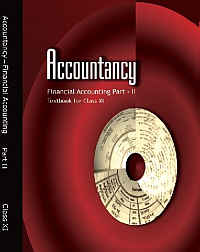NEW! The Gist (FREE) | E-BOOKS |
(Download) NCERT Book For Class XI : Accountancy - (Part -2)

(Download) NCERT Book For Class XI : Accountancy (Part - 2)
Table of Contents
- Chapter 9 Financial Statements - I
9.1 Stakeholders and Their Information Requirements
9.2 Distinction between Capital and Revenue
9.3 Financial Statements
9.4 Trading and Profit and Loss Account
9.5 Operating Profit (EBIT)
9.6 Balance Sheet
9.7 Opening Entry - Chapter 10 Financial Statements
10.1 Need for Adjustments
10.2 Closing Stock
10.3 Outstanding Expenses
10.4 Prepaid Expenses
10.5 Accrued Income
10.6 Income Received in Advance
10.7 Depreciation
10.8 Bad Debts
10.9 Provision for Bad and Doubtful Debts
10.10 Provision for Discount on Debtors
10.11 Manager’s Commission
10.12 Interest on Capital
10.13 Methods of Presenting the Financial Statements - Chapter 11 Accounts from Incomplete Records
11.1 Meaning of Incomplete Records
11.2 Reasons of Incompleteness and its Limitations
11.3 Ascertainment of Profit and Loss
11.4 Preparing Trading and Profit and Loss Account and the Balance Sheet - Chapter 12 Applications of Computers in Accounting
12.1 Meaning and Elements of Computer System
12.2 Capabilities of Computer System
12.3 Limitations of a Computer System
12.4 Components of Computer
12.5 Evolution of Computerised Accounting
12.6 Features of Computerised Accounting System
12.7 Management Information System and Accounting Information System - Chapter 13 Computerised Accounting System
13.1 Concept of Computerised Accounting System
13.2 Comparison between Manual and Computerised Accounting
13.3 Advantages of Computerised Accounting System
13.4 Limitations of Computerised Accounting System
13.5 Sourcing of Accounting Software
13.6 Generic Considerations before Sourcing an Accounting Software - Chapter 14 Structuring Database for Accounting
14.1 Data Processing Cycle
14.2 Designing Database for Accounting
14.3 Entity Relationship (ER) Model
14.4 Database Technology
14.5 An Illustration of Accounting Database
14.6 Relational Data Model
14.7 Relational Databases and Schemas
14.8 Constraints and Database Schemas
14.9 Operations and Constraint Violations
14.10 Designing Relational Database Schema
14.11 llustrating the Database Structure for Example Realities
14.12 Interacting with Databases - Chapter 15 Accounting System Using Database Management System
15.1 MS Access and its Components 15.2 Creating Tables and Relationships for Accounting Database
15.3 Vouchers Using Forms
15.4 Information Using Queries
15.5 Generating Accounting Reports
Printed Study Material for IAS Pre General Studies (Paper-1)
Get Gist of NCERT Books Study Kit for UPSC Exams
Printed Study Material for IAS Pre Exam
Go Back To NCERT Books Main Page
Courtesy : NCERT



